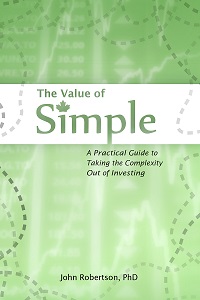Stop Over-Thinking Your Money
January 26th, 2014 by PotatoPreet Banerjee has a new book out called “Stop Over-Thinking Your Money!” (subtitled “The Five Simple Rules of Financial Success”). It’s at the pay-down-your-debt, balance-your-budget level of personal finance, so if you’re a regular reader here it may not quite be your speed. It is very approachable and light, so if you do need to find a first introduction to personal finance, this is a good choice. Preet starts off talking about what you need to get an “A” in personal finance vs an “A+”. I’m an academic so that kind of thing appeals to me, but from many of my students I think he maybe should have pitched it as what’s needed to get a “C+ and drunk”. And I do mean talking: he has a very conversational style, and encourages readers to tweet him as they go through the book. That’s also going to make it easy for a beginner to get into it.
I really liked this part on debt:
“Something to consider when you borrow money from a bank is that you aren’t ultimately borrowing money from the bank. You’re borrowing it from your future self. The bank is just the middleman between the two of you, and it charges interest for its services. […] Think of borrowing money as negotiating a pay-cut with your future self.” [emphasis as published]
Preet’s a car guy. Back when he had a regularly updated blog he’d often post racing videos, including a few of himself zooming around a closed track. This comes through in the book, as every other metaphor for life, spending, budgeting, or getting out of debt is related back to driving a car (or owning a car, or a car loan). If you are also a car guy then this is a great choice: you will find it extremely relatable, enjoyable, and relevant. If you are not a car guy, it will still be relatable — it’s not a terribly obtuse metaphor — though like me you may notice the prevalence of cars.
With a minimum of spoilers, the five rules break down to:
-
1. Disaster-proof your life.
2. Spend less than you earn.
3. Aggressively pay down high-interest debt.
4. Read the fine print.
5. Delay consumption.
In my book, I start off with a disclaimer that you should have these basics down (or something like them) before getting into the investing part I write about. Before I get into the more critical part of the review you should know that I’m going to add Stop Over-Thinking Your Money to the list of books to read before mine. So yes I liked it, but years of science and editing have hard-wired my brain into reviewing critically. Though Preet sent me a copy for free, it wasn’t to “blurb it”.
Disaster-proofing your life is a great place to start a book on personal finance. But in this initial a chapter on disaster planning, Preet spends 19 pages talking about insurance, and 5 pages on emergency funds. That’s a lot of focus on insurance, especially relative to emergency funds (and nothing on cash, lines of credit, or bottled water). This is something I should break off into its own post because I’m something of a bete noire of life insurance in personal finance blogging, so I will stop there. For all my quibbles on the relative emphasis of disaster-proofing components, Preet does an excellent job talking about insurance in this chapter. He goes into the issues with underwriting, with getting insurance at a young age and having the option to renew, and powers of attorney — all without it becoming a total snooze-fest (seriously!).
The other simple rules were inconsistent in the detail provided: Rule 4 was just 6 pages with one detailed example, and another brief one called up from Rule 1. I liked the discussions in Rule 5, particularly about renovations, but thought there was a lot of ground left to cover when it ended. In debt reduction he talked about methods like the snowball, but didn’t really go into much detail, just recommending Gail Vaz-Oxade’s book. He does mention the point he made in his TEDx talk about how people magically manage to run a balanced budget as soon as their ability to borrow more goes away, but it’s not made nearly as elegantly or persuasively as it was on the stage.
The 5 rules are just the first half of the book to get you ready for the investing part, which occupies the second half. I found the second half a little inconsistent in the level he was explaining things at. He fully explained the “all your eggs in one basket” metaphor (seriously: “If you have six eggs all in a basket and you drop that basket, then all your eggs are ruined. But if each egg has its own basket, then your chances of dropping and destroying all your eggs declines dramatically.”). But then he uses terms like standard deviation without defining them and only obliquely defines stocks and securities (several pages after starting to talk about them).
“Generally speaking, people put too much equity in their portfolio.” I haven’t really seen that myself, I’m usually trying to talk people into higher equity allocations — there’s so much risk aversion out there and stocks are tainted with the stigma of being unknown and weird. That might just be our different experiences: I tend to interact with young people just starting to learn about finances and investing, or else those from the research and health care fields, while his experience in the finance world (at Scotia with dimensional funds and Pro-Financial Asset Management) may have been with more serious investors. I loved his viewpoint on the investor risk questionnaires, how some people try to pick what they think the “correct” answer is to being a good investor, rather than what their actual risk tolerance is. Of course, it’s also just that you think you can tolerate a lot more risk when things are calm, only to panic when TSHTF.
A long chapter called “insurance 101” with graphs and percentages covering how payment leveling works and how the insurance company makes money off the arrangement concludes the book. I had trouble understanding why it was included — there’s already a really good, detailed section on insurance up front. Why so much granular detail on insurance, when nearly everything else is glossed over?
There are a number of comparisons to weight loss and dieting in the book. There is a lot of merit to that analogy: meeting a budget is fairly similar, whether it’s a calorie budget or a dollar one. The concepts and the math are not difficult, it’s just a matter of discipline. However valid it is, I don’t think it’s such a helpful comparison to make. Eating right and staying in shape are notoriously difficult in practice. I don’t think finances and saving are nearly as challenging — a point Preet himself makes on page 3 — so hammering on this metaphor may demystify finance but make many lose hope for actually managing to stick to the principles.
Preet makes the case that you don’t need to put in a ridiculous amount of work to get an A+ in finance if you can stop over-thinking your money to get an easy A. The book is a breezy read and hits the major points so it’s easy to recommend for beginners. But I’d say that “easy A” is a B- at best: many how-tos are missing, which is odd given the bang it started off with on insurance detail; core areas of personal finance like taxes, downpayments, RESPs are not mentioned at all; and Kerry Taylor gets as many mentions as retirement (pensions/CPP: not at all). There’s such a void in this segment of the personal finance education: there are a metric crapton of books for those who are in debt to their eyeballs, and even more investing tomes for those who have the basics figured out, but not much for those just starting out and needing a gentle introduction to getting their house in order (indeed, really the only other one I consistently recommend is The Wealthy Barber Returns). So despite all my (hopefully constructive) criticism above, there is a group of people out there who have an unmet need for a book like this.
Giveaway: Preet gave me a review copy, which I will pass along to someone in gently used condition. Between Feb 6 and 15, I’ll randomly select from comments below that:
1. Say which city and province they’re writing from [Canadians only; GTA-north or Discovery District-area people will get it hand-delivered because I’m too cheap to pay for shipping if I can avoid it and Preet didn’t bribe me even a little bit for the review].
2. Include a 20-200 word discussion on what state their finances and/or financial knowledge and/or that of their friends are in now and/or what simple rule of financial success you would have put in the book [this will be your skill-testing question and human filter].
3. Indicate whether they want the book for themselves or a friend.
4. Are received by 11:59pm on Wednesday February 5th, for whichever time zone my blog server decides it wants to be in that day.



 Questrade: use QPass 356624159378948
Questrade: use QPass 356624159378948 Passiv is a tool that can connect to your Questrade account and make it easier to track and rebalance your portfolio, including the ability to make one-click trades.
Passiv is a tool that can connect to your Questrade account and make it easier to track and rebalance your portfolio, including the ability to make one-click trades.